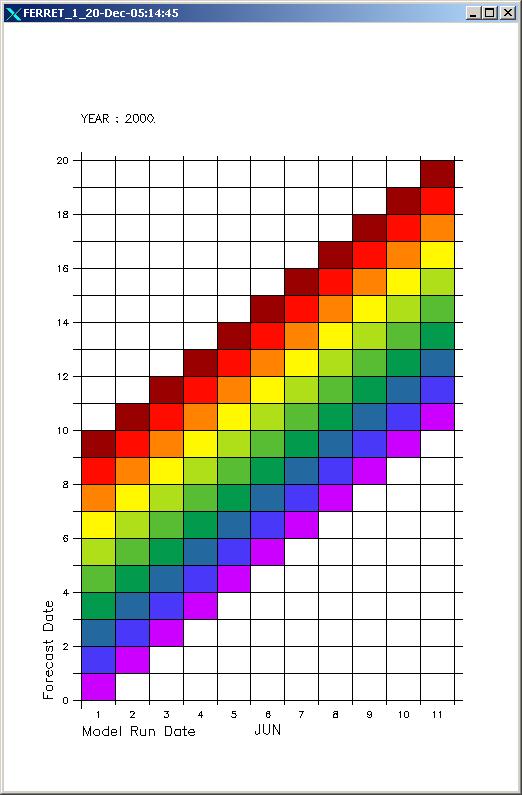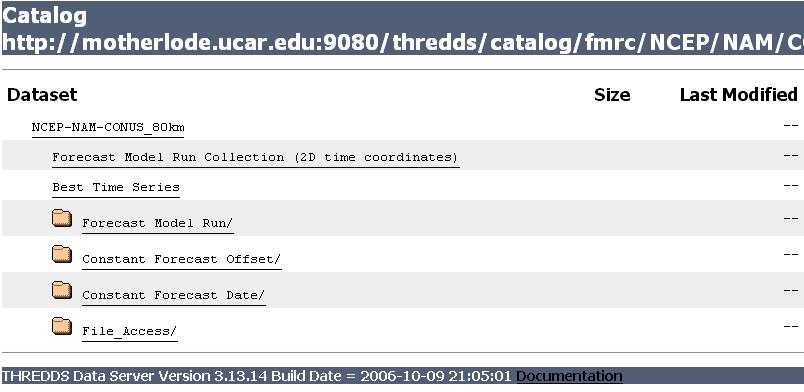
See also: Annotated NcML Schema
A forecast model is a scientific model that predicts the time evolution of a system starting from some initial state. Its output is a time series for each of its variables, which may be state variables or derived variables. The model is often run periodically, so one may have a collection of different runs. The collection of data output for a particular model run is called a forecast model run, which may be output in a single file or in several files. The model is run periodically, and so one may have a collection of forecast model runs, which we assume can be uniquely identified by the start of the model run, called the model run time, also called the analysis time or generating time.
The time series for a forecast model run is the list of forecast times, also know as the valid times. (For our purposes, the forecast times are just whatever the time series is, ignoring whether its a forecast or a nowcast, etc.). The difference between the run time and the forecast time is the forecast offset, sometimes called the forecast hour.
The ucar.nc2.dt.GridDatatype is the CDM scientfic datatype for grids. It has been generalized to allow two time dimensions, called the runtime and time dimensions, in order to represent collections of forecast model runs. Such a dataset can be created by writing a single file, or by using NcML aggregation to create a virtual dataset out of multiple files.
Both the runtime and time coordinates may have type String or char and hold ISO 8601 dates, or have a udunit date unit string in its units attribute. For example:
String runtime(run=8);
:long_name = "Run time for model";
:standard_name = "forecast_reference_time";
:_CoordinateAxisType = "RunTime"; data: "2006-09-05T12:00:00Z", "2006-09-06T12:00:00Z", "2006-09-07T12:00:00Z", "2006-09-08T12:00:00Z", "2006-09-09T12:00:00Z", "2006-09-10T12:00:00Z", "2006-09-11T12:00:00Z", "2006-09-12T12:00:00Z"
The time coordinate is the forecast (valid) time, and it will differ for each run, and so will be two dimensional:
double time(run=8, time=16);
:units = "hours since 2006-09-05T12:00:00Z";
:long_name = "forecast (valid) time";
:standard_name = "time";
:_CoordinateAxisType = "Time"; data: {90.0, 96.0, 102.0, 108.0, 114.0, 120.0, 126.0, 132.0, 138.0, 144.0, 150.0, 156.0, 162.0, 168.0, 174.0, 180.0}, {114.0, 120.0, 126.0, 132.0, 138.0, 144.0, 150.0, 156.0, 162.0, 168.0, 174.0, 180.0, 186.0, 192.0, 198.0, 204.0}, {138.0, 144.0, 150.0, 156.0, 162.0, 168.0, 174.0, 180.0, 186.0, 192.0, 198.0, 204.0, 210.0, 216.0, 222.0, 228.0}, {162.0, 168.0, 174.0, 180.0, 186.0, 192.0, 198.0, 204.0, 210.0, 216.0, 222.0, 228.0, 234.0, 240.0, 246.0, 252.0}, {186.0, 192.0, 198.0, 204.0, 210.0, 216.0, 222.0, 228.0, 234.0, 240.0, 246.0, 252.0, 258.0, 264.0, 270.0, 276.0}, {210.0, 216.0, 222.0, 228.0, 234.0, 240.0, 246.0, 252.0, 258.0, 264.0, 270.0, 276.0, 282.0, 288.0, 294.0, 300.0}, {234.0, 240.0, 246.0, 252.0, 258.0, 264.0, 270.0, 276.0, 282.0, 288.0, 294.0, 300.0, 306.0, 312.0, 318.0, 324.0}, {258.0, 264.0, 270.0, 276.0, 282.0, 288.0, 294.0, 300.0, 306.0, 312.0, 318.0, 324.0, 330.0, 336.0, 342.0, 348.0}
The data variables will generally have both the runtime and time dimensions, as well as the z, y, and x dimensions:
float Dew_point_temperature(run=8, time=16, height_above_ground1=1, y=689, x=1073);
:units = "K";
:long_name = "Dew point temperature @ height_above_ground";
A dataset with a runtime dimension and a 2D time dimension as described here is called an FMRC (Forecast Run Model Collection) dataset. You can open it as an ordinary dataset and manipulate it through the NetcdfFile or NetcdfDataset APIs.
More typically you want to open it as a ucar.nc2.dt.GridDataset, so that the grid variables are found and made into ucar.nc2.dt.GridDatatype objects, and especially so that the time coordinates are found through methods on the ucar.nc2.dt.GridCoordSystem:
public CoordinateAxis1DTime getRunTimeAxis(); public CoordinateAxis1DTime getTimeAxisForRun(int run_index);
Possibly more interesting is to make it into a ucar.nc2.dt.fmrc.ForecastModelRunCollection object, which allows you to view the
dataset in several ways. This option is described in section 4 below.
A common case is that the model output is spread out in multiple files. A special kind of NcML aggregation can be used to create an FMRC dataset.
This case is similar to a JoinNew aggregation, in that a new, outer dimension is created, and each file becomes one slice of the new dataset.
<?xml version="1.0" encoding="UTF-8"?>
(1)<netcdf xmlns="http://www.unidata.ucar.edu/namespaces/netcdf/ncml-2.2" enhance="true" >
(2) <aggregation dimName="runtime" type="forecastModelRunCollection"> (3) <netcdf location="file:/data/ldm/NAM_CONUS_80km/Run_20060910_0000.grib1" coordValue="2006-09-10T00:00:00Z" enhance="true" />
<netcdf location="file:/data/ldm/NAM_CONUS_80km/Run_20060910_0600.grib1" coordValue="2006-09-10T06:00:00Z" enhance="true" />
<netcdf location="file:/data/ldm/NAM_CONUS_80km/Run_20060910_1200.grib1" coordValue="2006-09-10T12:00:00Z" enhance="true" /> </aggregation>
</netcdf>
Equivalently, you can use an NcML scan element:
<?xml version="1.0" encoding="UTF-8"?>
<netcdf xmlns="http://www.unidata.ucar.edu/namespaces/netcdf/ncml-2.2" enhance="true" >
<aggregation dimName="run" type="forecastModelRunCollection"> (1) <scan location="/data/ldm/NAM_CONUS_80km/" suffix=".grib1" dateFormatMark="Run_#yyyyMMdd_HHmm" enhance="true" /> </aggregation>
</netcdf>
A runtime dimension and coordinate variable is added, and the time coordinate is made into a 2D coordinate, as required for an FMRC datasset:
double time(run=3, time=11);
:units = "hours since 2006-09-10T00:00:00Z";
:long_name = "Coordinate variable for time dimension";
:standard_name = "time";
:_CoordinateAxisType = "Time";
This example assumes that all the time coordinates in each of the files have the same units, in this example, "hours since 2006-09-10T00:00:00Z". If thats not the case, then the time values must be read in and adjusted to have a common unit, which is indicated by adding the timeUnitsChange attribute on the aggregation element:
<aggregation dimName="run" type="forecastModelRunCollection" timeUnitsChange="true">
When you have a different number of forecast times in each model run, you must also use the timeUnitsChange attribute on the aggregation element (as of 4.0.18).
In this case we can use nested aggregations, the inner aggregation to join the files together that make one run, then an outer aggregation to make the runs into an FMRC dataset. The following is a single FMRC that shows 3 variations on how to do the inner aggregations:
<?xml version="1.0" encoding="UTF-8"?>
<netcdf xmlns="http://www.unidata.ucar.edu/namespaces/netcdf/ncml-2.2" enhance="true">
(1)<aggregation dimName="run" type="forecastModelRunCollection"> (2) <netcdf coordValue="2006-09-10T00:00:00Z"> (3) <aggregation dimName="Time" type="joinExisting"> (4) <netcdf location="file:/data/ldm/NAM_CONUS_80km/Run_20060910_0000/Hour_F00.grib1" coordValue="0"/>
<netcdf location="file:/data/ldm/NAM_CONUS_80km/Run_20060910_0000/Hour_F03.grib1" coordValue="3"/>
<netcdf location="file:/data/ldm/NAM_CONUS_80km/Run_20060910_0000/Hour_F06.grib1" coordValue="6"/> </aggregation> </netcdf> (5) <netcdf coordValue="2006-09-10T06:00:00Z"> <aggregation dimName="Time" type="joinExisting"> (6) <scan location="/data/ldm/NAM_CONUS_80km/Run_20060910_0600/" suffix=".grib1" /> </aggregation> </netcdf> (7) <netcdf coordValue="2006-09-10T12:00:00Z"> (8) <variable name="Time" shape="Time" type="int"> <attribute name="long_name" value="Forecast Time"/> <attribute name="units" value="hours since 2006-09-10T12:00:00Z"/> <attribute name="_CoordinateAxisType" value="Time"/> <values start="0" increment="1"/> </variable> <aggregation dimName="Time" type="joinExisting"> <scan location="/data/ldm/NAM_CONUS_80km/Run_20060910_1200/" suffix=".grib1" /> </aggregation> </netcdf> </aggregation
</netcdf>
In the case where the data has a single time step in each file, and we can figure out the runtime and forecast time from each file's pathname, we can use a special aggregation type called forecastModelRunSingleCollection, and a special form of the scan element called scanFmrc.
<?xml version="1.0" encoding="UTF-8"?>
<netcdf xmlns="http://www.unidata.ucar.edu/namespaces/netcdf/ncml-2.2">
(1) <aggregation dimName="run" type="forecastModelRunSingleCollection" timeUnitsChange="true" >
(2) <scanFmrc location="/data/grib/rtmodels/" regExp=".*_nmm\.GrbF[0-9]{5}$"
(3) runDateMatcher="yyMMddHH#_nmm.GrbF#"
(4) forecastOffsetMatcher="#_nmm.GrbF#HHH"/>
</aggregation>
</netcdf>
In this example, the files are named, for example 06091212_nmm.GrbF03000. The regular expression ensures that only files that have a literal "_nmm.GrbF" in the name, followed by exactly 5 digits, and nothing afterwards, will be used. The runDateMatcher matches the literal "_nmm.GrbF" in the file's full pathname, then applies the java.text.SimpleDateFormat yyMMddHH to the 8 characters that come before the match, to derive the run date coordinate. The forecastOffsetMatcher also matches the literal "_nmm.GrbF", then turns the 3 characters after the match into a double, to calculate the hour offset from the run date.
Another example:
<scanFmrc location="C:/data/rap/" suffix=".nc" subdirs="true"
runDateMatcher="yyyyMMddHH#/wrfout_d01_#"
forecastDateMatcher="#/wrfout_d01_#yyyy-MM-dd_HHmm"/>
works on the files in the directory C:/data/rap/ and its subdirectories that end in ".nc". These files are named, for example C:/data/rap/2006070611/wrfout_d01_2006-07-06_080000.DPG_F.nc. The runDateMatcher matches the literal "/wrfout_d01_" in the file's full pathname, then applies the SimpleDateFormat yyyyMMddHH to the 10 characters that come before the match, to derive the run date coordinate. The forecastDateMatcher also matches the literal "/wrfout_d01_", then applies the SimpleDateFormat yyyy-MM-dd_HHmm to the 15 characters that come after the match, to derive the forecast time coordinate. Note that in this forecastDateMatcher example, the "-" and "_" characters are literals, and the other chanarcters "y", "M", "d", "H" are special characters that match year, month, day and hour numbers, respectively. The dates are assumed to be GMT unless otherwise specified. See java.text.SimpleDateFormat for more details of how date matching works.
<netcdf xmlns="http://www.unidata.ucar.edu/namespaces/netcdf/ncml-2.2">
<aggregation dimName="runtime" type="forecastModelRunCollection" recheckEvery="10min" timeUnitsChange="true">
<variableAgg name="my_vertical_coord"/>
<scan location="test" dateFormatMark="ncom_glb_reg7_#yyyyMMdd" subdirs="false"/>
</aggregation>
</netcdf>
In Figure 1, a ten day forecast with daily output snapshots is made once a day.

Figure 1. A Forecast Model Runs Collection (FMRC)
If you wrap an FMRC dataset in a ucar.nc2.dt.fmrc.ForecastModelRunCollection, you can then create different views of the dataset that all have 1D time coordinates. You might use a FmrcImpl constructor, an implementation of the ForecastModelRunCollection interface:
public FmrcImpl(String location); public FmrcImpl(NetcdfDataset ncd);
You can then extract the following views of the dataset from the ForecastModelRunCollection object:
public List getRunDates(); // possible run dates; List<Date> public NetcdfDataset getRunTimeDataset( Date runTime); // one model run public List getForecastDates(); // possible forecast dates; List<Date> public NetcdfDataset getForecastTimeDataset( Date forecastTime); // constant forecast date
public List getForecastOffsets(); // possible forecast offsets; List<Double> public NetcdfDataset getForecastOffsetDataset( double offset); // constant forecast offset
public NetcdfDataset getBestTimeSeries( );
The getRunTimeDataset() method will return a forecast model run dataset representing one of the vertical columns in Figure 1 (above). The getRunDates() method returns a list of the valid run times.
The getForecastTimeDataset() method will return a constant forecast date dataset representing one of the horizontal columns in Figure 1. The getForecastDates() method returns a list of the valid forecast times. This kind of dataset has successively shorter forecasts of the same endpoint. The final timestep is a nowcast (where T=0 for the run).
The getForecastOffsetDataset() method will return a constant forecast offset dataset representing one of the diagonals in Figure 1. The getForecastOffsets() method returns a list of the valid forecast offsets, normally in units of hours. For example, in Figure 1, you might compare the nowcast dataset (offset = 0, purple diagonal) from the 3 day forecast dataset (dark blue diagonal), to track how well the model does in its 3 day forecasts.
Finally, the getBestTimeSeries() method creates the "best" time series over the collection. In Figure 1 it will include the nowcasts (purple diagonal) as well as the latest model forecasts (rightmost column).
The datasetFmrc element has been replaced by the featureCollection element in TDS 4.2. The result in a TDS catalog is the same however:

 This document is maintained by Unidata. Send comments to THREDDS support. Last updated: November 2010
This document is maintained by Unidata. Send comments to THREDDS support. Last updated: November 2010